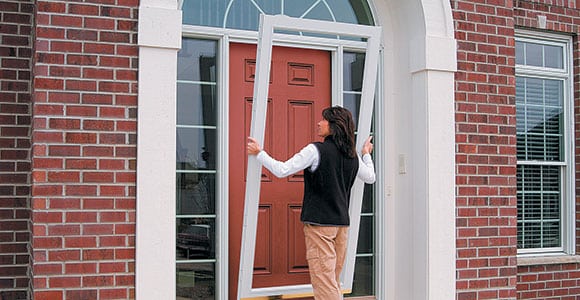Dear Jim: I feel air leaks around my doors, so I thought about adding storm doors. I want ones that also have screens, but my budget is limited. Is it worthwhile adding storm doors, and what should I look for? — Candi M.
Dear Candi: Even though a door is a relatively small area as compared to an entire wall of a house, just one door can lose a significant amount of energy. Before buying anything new, make sure your primary doors are as airtight as possible. Adding storm doors can certainly improve the energy efficiency of almost any house, but they are not designed to correct efficiency problems of an old, warped primary door.
The quality of the storm door construction is important for a nice appearance, long life and security. It must withstand a lot of abuse, so don’t just pick the cheapest one. From strictly an energy efficiency standpoint, though, the most important factors are the dead air space between the storm and primary doors and how well wind is blocked.
Buying an aluminum storm door and installing it yourself is the typical low-cost option. They’re very lightweight and made to fit standard-sized openings, so installing one is a simple do-it-yourself project.
When you see the door on display attached to a wooden frame at the store, the aluminum frame will feel very strong. When you open the box at home, you may find the unattached aluminum frame strips are somewhat flexible. Be careful not to kink them during handling. Apply a generous bead of caulk on the back of the aluminum frame when screwing it to the door frame.
If you plan to use natural ventilation during the summer, a self-storing, triple-track storm/screen door is your most convenient option. I use this type at my own home. The screen panel has its own vertical track in the door, so it never has to be removed. At the end of winter, just slide one of the glass panels down and slide the screen panel up for ventilation.
When your budget does open up someday, some very attractive all-wood-frame (made with mortise and tenon joints) storm/screen doors are available. These are strong and secure but do require some regular maintenance similar to any wood door. For added security, ornate wrought iron storm doors are available with actual deadbolts and very tough, break-in-resistant stainless steel screens.
If your budget is really tight, consider making your own storm door. It is easy to mount hinges in the existing door opening for the storm door. Make a simple wooden frame with only the top half open and a plywood lower panel. This panel improves rigidity for a more airtight seal and better durability.
Most home-improvement stores carry sheets of clear acrylic plastic to mount in the frame. Make another narrow wooden frame slightly larger than the open half and mount the acrylic sheet in it. Screw it over the storm door opening. Make a similar frame with screening in it for summer use.
If you prefer more durability and efficiency and a perfectly clear view outdoors is not critical, select double-walled polycarbonate instead of acrylic.
Nail spring-steel weather stripping in the door opening on the latch side and top and bottom. This type of weather stripping is very durable where there is sliding friction. Adhesive-backed foam weather stripping is effective in compression on the hinge side.
The following companies offer storm/screen doors: Cumberland Woodcraft, 800-367-1884, www.cumberlandwoodcraft.com; Emco Specialties, 800-933-3626, www.emcodoors.com; Homeguard Industries, 800-525-1885, www.home-guard.net; Pella, 877-473-5527, www.pella.com; and ProVia Door, 877-389-0835, www.proviadoor.com.



